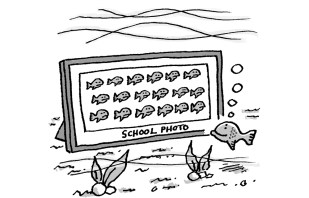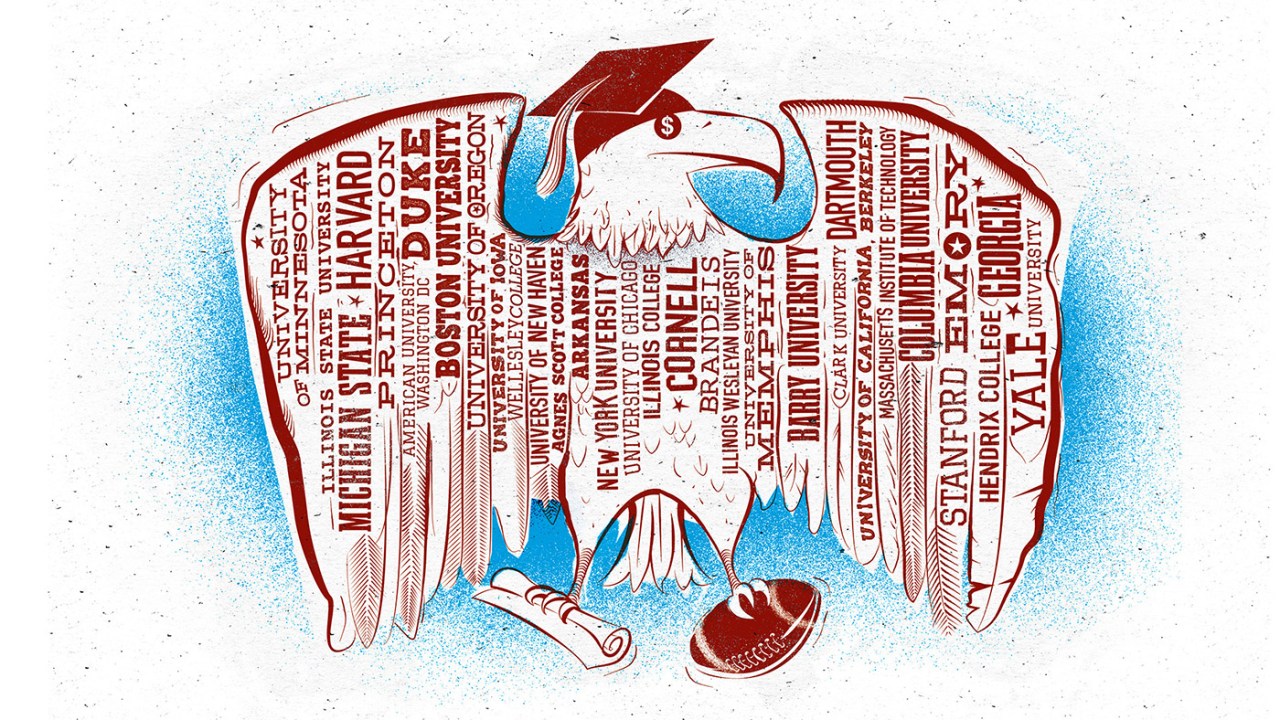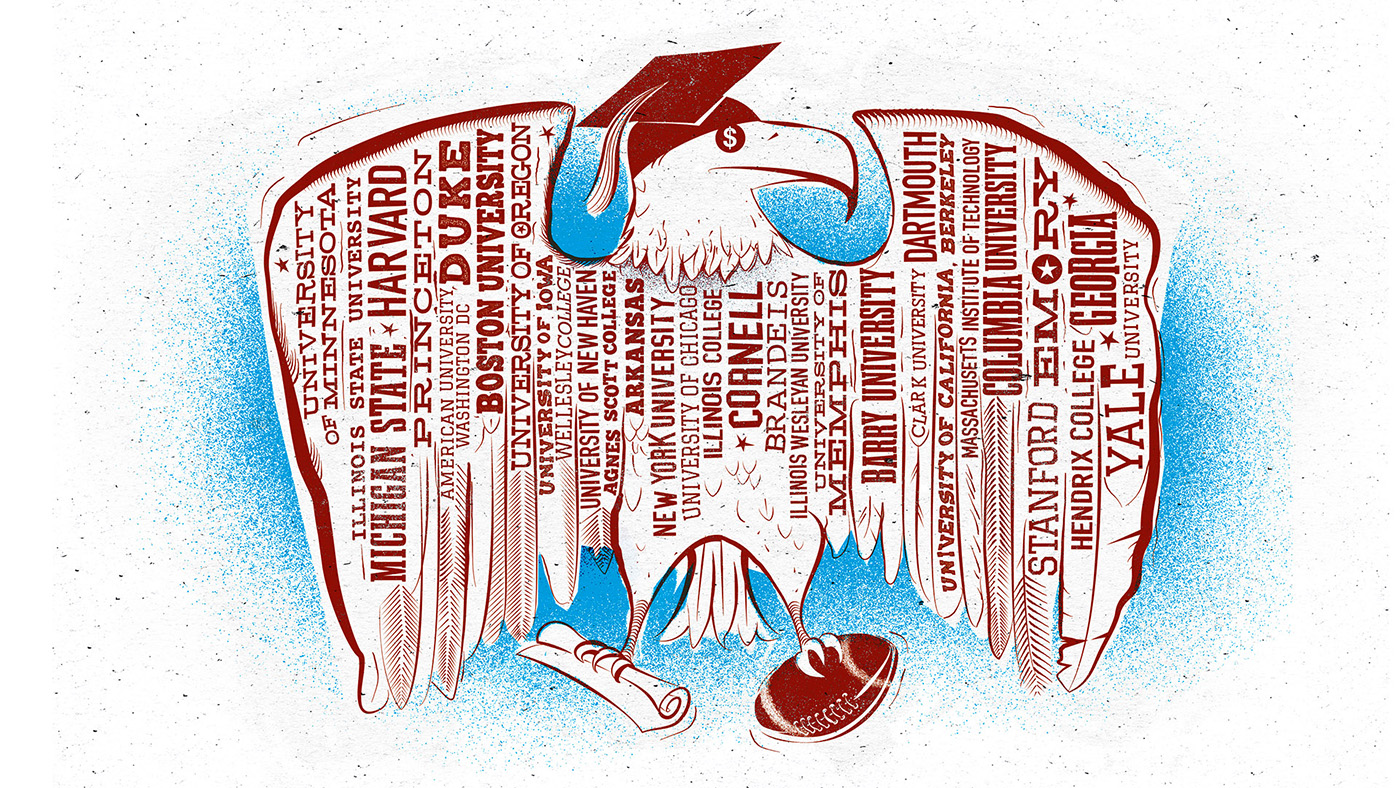Angela McAuslan-Kelly is a normal sixth-former at Robert Gordon’s College in Aberdeen. Her dad is a bus driver and her mum works in a coffee shop. ‘They are not very wealthy,’ explains Holly Cram, a former captain of the Scottish national women’s hockey team. Angela, though, is off to Princeton in September.
‘I completely get why students want to do it. They are sold on the dream of getting a scholarship’
The reason is American universities’ extraordinarily generous scholarships, especially for sports. ‘She is very bright and she is very good at chucking a heavy thing on a wire,’ laughs Cram. Angela’s love of hammer throwing means she will soon find herself rubbing shoulders with the scions of American business.
‘University sports is close to a $5-billion-a-year industry in the US,’ says Cram, who set up Aspire, a company that specialises in getting sporty kids to an American university. ‘It’s not just the obvious sports like soccer. We’ve placed pupils on water polo and golf scholarships.’ Depending on the sport, if your child plays at county level, you stand a seriously good chance of getting a full scholarship to an American university. There are even ten-pin bowling and cheerleading scholarships – though most Brits are going to struggle to land one of those.
Cram admits that the majority of her clients are wealthy and most go to private schools. But she also lays on exhibition hockey matches for US college coaches scouting for top players and occasionally waives her fees for exceptional pupils from modest backgrounds. ‘More and more families who aren’t wealthy are considering it. If you do the sums and get an 80 per cent scholarship, it’s cheaper to go to the US than the UK.’
You don’t even need to be able to throw a hammer or bowl a strike to be considered for a full scholarship. ‘A handful of schools are what’s called need-blind,’ explains Alexandra Burston, who went to Yale and now runs TRP Education, which helps children in the UK apply to American universities. ‘They do a very comprehensive financial check on your family and then you pay the school fees that they deem that you can afford.’ If your child is good enough to get a place but you aren’t wealthy, you may not have to pay a penny, even for travel.
On paper, the top American universities – from Amherst ($80,050 a year) to Yale ($82,170) – charge eye-watering sums to those from out of state. Scholarships change that equation. Take Harvard, for instance, where the upfront cost is $78,028 for out-of-state students, including those from other countries. But 57 per cent of its international students enjoy financial aid of some sort, taking the $78,000 down to an average of around $11,000.
A small but increasing number of British students are taking advantage. This year 1,811 put in applications to study at US colleges via the Common App website, the American equivalent of Ucas. While this is still a small number compared with the 315,000 pupils who applied to a British university at the same time, it’s also bigger than it used to be.

The funding that American colleges offer has emboldened the Sutton Trust, one of the main charities dedicated to improving the educational chances of disadvantaged British children. ‘America’s leading universities and colleges look to attract talented students, whatever country or social background they come from. That’s how it should be,’ says Sir Peter Lampl, the charity’s chairman. ‘Offering need-blind places with full financial aid is crucial to levelling the playing field.’
Each year the Sutton Trust offers 150 British school pupils a place at its summer school. It doesn’t only help them with the application process but also takes them over to America for a week to show them some of the colleges. Of those 150 on the scheme last year, 86 went on to apply to a US university and 51 were offered a place, including four at Princeton, two at Yale and two at Harvard. They received $16.5 million in financial aid between them, all getting full scholarships.
Ibrahim Butt, 24, now a management consultant in London, grew up in Blackburn; his father is a mechanic and his mother a housewife. He went on the Sutton Trust course in 2015. ‘I had barely been outside of the north-west but I thought it was an incredible opportunity and an adventure,’ he says. Thanks partly to his 9 A*s at GCSEs, Butt was offered a place at Duke University in North Carolina on a full scholarship. ‘I graduated debt-free,’ he explains. ‘I also got all my room, board, food and travel to and from the UK paid for.’ And that was along with money to allow him to travel around the world during the summer holidays on various placements.
But his academic grades were not the only appeal to Duke, ranked a top ten US university. ‘What I like about American universities is their holistic approach,’ says Butt. ‘They look at your academics, but also your community involvement, your leadership.’ The fact that he was his school’s head boy and was involved in a Blackburn community charity won him lots of bonus points – something British universities do not take into account so much at admission.
This holistic approach is one of the fundamental differences in the American application process. Parents hoping to send their children to the US should be thinking, quite early on, about how to demonstrate that their child is well-rounded. Charity work helps, of course, but so do extracurricular activities: anything from debating clubs to archery to amateur rocket workshops. It’s important to remember that exam results alone won’t get your child into a top American college.
Even with the right credentials, the application process is not easy. Pupils need to submit three separate references from different teachers. And unlike a single personal statement for a Ucas form, the American system requires multiple personal essays which demonstrate attitude and personality. A recent question from one college was: ‘If you had ten minutes and the attention of one million people what would you talk about?’
Then there are the ACTs or SATs aptitude tests, which though frequently voluntary are heavily recommended. They are split into the evidence-based reading and writing section, which tests English and comprehension skills, and the maths section.
One particularly helpful resource is the Fiske Guide to Colleges, which lays out the strengths of each American university – from campus life to particularly competitive subjects. This should help both you and your child work out what to focus on in their applications, as well as to choose which college is best for them.
This complexity, along with the myriad of different scholarships available, means that only a few top state schools have started to offer help with applications. One is Harris Academy, Westminster. ‘It feels like a big adventure. It feels exciting,’ says James Handscombe, executive principal of the Harris Federation. ‘I completely get why students want to do it. They are sold on the dream of getting a scholarship.’
Eight of the academy’s leavers got offers from American colleges last year, including Berkeley and New York University. Interestingly, just three accepted. Handscombe is not surprised so few took the leap. The colleges may have incredible stadiums, laboratories, concert halls and accommodation, and offer almost unlimited money to talented children – but they are also a long way away. ‘A big point of the years 18 to 21 is learning to be an independent adult. It is a lot easier to do that if you can go home on weekends. If you go to America, you just can’t do that.’
In the independent sector, however, help with the application process has become standard, even if only some students will be offered the same discount on fees. Many private schools now have a senior teacher dedicated to American university applications, alongside the staff specialising in Oxbridge entrance.
In its sixth form prospectus, Westminster’s head of US University Admissions, Lydia Timpson, explains how every October half-term, the school organises a trip to America for pupils to visit various colleges. Its most recent trip saw them take in ‘a Broadway show, shopping, national museums in Washington DC, and various culinary delights. One of the most insightful and inspirational parts of the trip was to visit Westminster alumni currently studying at these universities’.
This effort is paying off. Westminster sent 35 pupils out of 200 to American universities last year including seven to Stanford and four to Columbia. At Winchester, the Prime Minister’s alma mater, 10 per cent of leavers went to an American university; at Millfield, it was 18 per cent.

One of this year’s privately educated applicants is Harry Pincus, who’s doing his A-levels at City of London School. He has applied to seven American universities along with UK ones and has set his heart on the University of Southern California, which he visited last year. ‘The campus and the whole atmosphere just blew me away,’ he says. ‘I’ve visited Loughborough, I’ve visited Bristol and they were nice, but you go to USC and it’s a completely different world. The facilities are just on another level. You only have to look at the stadiums to see – the college stadium is 80,000 capacity. That’s bigger than any team in the Premier League.’
His view is echoed by those who have been educated in America. ‘A lot of US universities have substantial endowments and they invest a lot of that money into student life,’ says Alexandra Burston, a former US student turned TRP mentor. ‘The campuses are amazing, the extra-curricular experience is amazing, and you tend to get a lot more teaching contact with your professors than in a UK university.’
Before British institutions were allowed to start charging fees – now as much as £9,250 a year – many 18-year-olds went to university with little expectation beyond having a good time away from home. These days, considering most will leave with substantial student debts, they expect something more. Those UK universities that offer little teaching, often online, and poor facilities no longer seem so appealing. No wonder those who can are looking across the Atlantic.







Comments